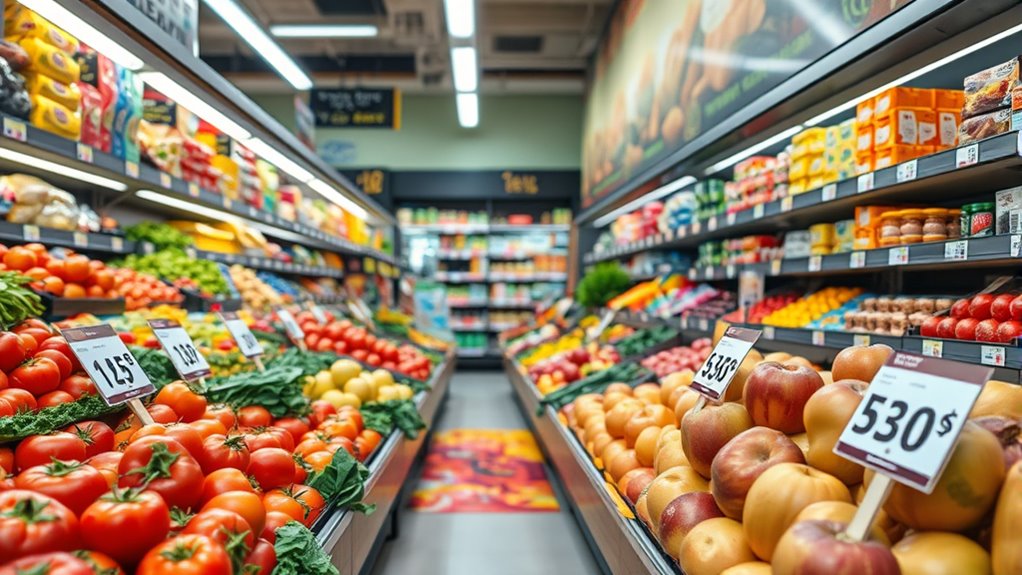Food prices are likely to stay high through 2025, making grocery bills a continued challenge. Supply chain disruptions, weather issues, and trade restrictions keep costs elevated in many sectors. While some prices, like cereals, ease at times, overall inflation persists, especially for meat and vegetable oils. If these trends continue, your grocery expenses may remain strained. Keep exploring to understand what factors will shape your food costs in the coming years.
Key Takeaways
- Food prices are influenced by ongoing supply chain disruptions, trade restrictions, and geopolitical factors, likely causing continued increases through 2025.
- Fluctuations in global commodity markets, such as cereals and vegetable oils, suggest that some food categories may remain costly.
- Market volatility and speculation could lead to unpredictable shifts in grocery bills, with potential for both rises and temporary stabilizations.
- Persistent demand for protein-rich foods and meat may sustain higher prices, impacting overall grocery costs.
- Policy changes, climate impacts, and trade dynamics will continue to shape food prices, making future grocery bills uncertain but generally elevated.

Are food prices in 2025 set to keep climbing? It’s a question many of us are asking as grocery bills continue to rise despite some fluctuations. The global Food Price Index (FFPI) recently reached 128.0 points in June, marking a modest increase of 0.5% from the previous month. While some food categories are easing, others are pushing prices higher, and trade policies along with supply chain disruptions play a significant role. Tightened trade restrictions or tariffs can limit the flow of essential goods, making imported ingredients more expensive. Meanwhile, ongoing supply chain issues—stemming from weather events, logistical bottlenecks, or geopolitical tensions—continue to hinder the steady movement of food products across borders, driving prices upward. Global supply and demand dynamics are also shifting rapidly, adding further pressure on prices. Take cereal prices, for example. In June, the FAO Cereal Price Index fell by 1.5%, mainly because of declining prices for maize, barley, and sorghum. That’s partly due to expectations of a record corn harvest in the U.S., which increases supply and puts downward pressure on prices. However, wheat prices rose during the same period, mainly because adverse weather affected major wheat-producing regions, constraining supply. These contrasting trends reflect how supply chain disruptions and trade policies can unevenly impact different food sectors, creating a complex picture for consumers. If trade restrictions tighten or transportation bottlenecks worsen, prices for some staples could spike even further. Additionally, market speculation can also influence commodity prices, adding volatility to the food market. Vegetable oil prices tell a different story. In June, they climbed by 2.3%, driven by higher palm, rapeseed, and soy oil prices. Policy adjustments in the biofuel sector and strong demand—particularly from the biofuel industry—are boosting prices. These market dynamics are heavily influenced by global trade policies that regulate biofuel mandates and tariffs, shaping the supply and demand balance. Fluctuations in vegetable oil prices demonstrate how interconnected global markets are, with supply chain disruptions or policy shifts capable of causing rapid price swings. If trade policies become more restrictive or supply chains face new hurdles, vegetable oil prices could remain volatile. On the meat front, prices are climbing across most categories, except poultry. The overall Meat Price Index hit a record high, with higher international prices for bovine, ovine, and pig meats. These increases are fueled by global demand and supply constraints, often linked to trade policies affecting exports and imports. Disruptions in supply chains, whether from disease outbreaks or transportation issues, limit the availability of meat products, driving prices higher. With continued uncertainties in trade relations and supply chains, grocery bills for meat could stay elevated or even rise further. [Furthermore, rising consumer preferences for protein-rich diets are also supporting higher meat prices.
Frequently Asked Questions
How Will Climate Change Affect Future Food Prices?
Climate change will likely increase future food prices by reducing crop yields and causing more extreme weather events. You’ll see higher costs as farmers struggle to adapt through climate adaptation strategies like crop rotation and pest management. These efforts help, but unpredictable weather and resource limitations still threaten supply. As a result, food availability may become more volatile, pushing prices higher and making it harder for you to access affordable, stable food supplies.
Will Technological Advances Lower Grocery Costs by 2025?
Imagine a smart garden where every plant’s growth is guided by AI. Similarly, technological advances like agricultural automation and food waste reduction can lower grocery costs by 2025. These innovations streamline supply chains, cut waste, and optimize inventory. As a result, you may find prices more stable, and shopping easier, because automation and data-driven decisions help retailers save money—savings they can pass on to you.
Are There Regional Differences in Food Price Trends?
You’ll notice regional disparities in food price trends, with some areas experiencing higher price fluctuations than others. For example, the Northeast saw a 2.5% increase, while states like Colorado and Michigan had smaller rises around 3%. These regional differences are driven by factors like supply chain issues, weather events, and local demand, causing varied price fluctuations across regions. So, your grocery bills may rise differently depending on where you live.
What Impact Will Global Trade Policies Have on Prices?
Imagine a global marketplace as a busy highway, with trade tariffs and import restrictions acting like roadblocks that slow traffic. These barriers drive up costs for food and beverages everywhere, making your grocery bills higher. As countries impose tariffs, the price of imported goods climbs, and supply chains tighten. You feel it at checkout—more expensive items and fewer choices—showing how trade policies directly shape what you pay and what’s on your plate.
How Might Consumer Habits Influence Future Grocery Bills?
Your shopping habits and dietary choices will shape future grocery bills. As you prioritize health, convenience, and exploration, you may seek deals or opt for online shopping, which can influence costs. Choosing healthier or specialty foods might increase expenses, while bargain-hunting and meal planning can help control costs. Overall, your preferences for convenience and wellness will drive market trends, impacting prices and how much you spend at the store.
Conclusion
As you navigate the grocery aisles in 2025, remember that food prices are like a rollercoaster—full of ups and downs. While costs may continue to rise and fall unpredictably, staying informed and flexible helps you stay on track. Don’t let the shifting tides catch you unaware; instead, steer your budget wisely through this ever-changing landscape. With a little planning, you’ll find your way, even when prices feel like a wild ride.










